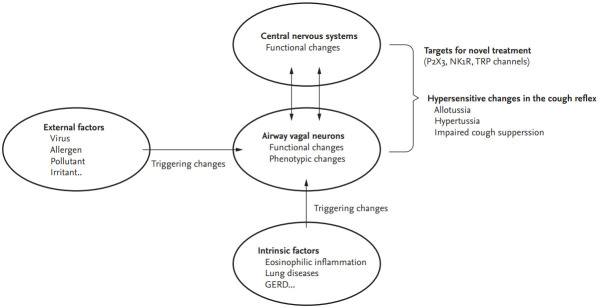Figure 1.
Schematic presentation of pathophysiologic components of cough hypersensitivity syndrome. Functional or phenotypic changes in peripheral sensory neurons are the first-level adaptive host responses in terms of developing cough reflex hypersensitivity, and may be accompanied by functional changes in the central neural processing of the cough reflex. These changes are now considered central to chronic cough. Primarily, the changes may be triggered by external factors such as viral infection, allergens, air pollutant or irritants, but also by intrinsic factors (disease conditions) such as eosinophilic inflammation, lung diseases, or gastroesophageal reflux disease. Patients with chronic cough commonly present with hypersensitivity, including allotussia, hypertussia, and impaired cough suppression, although the pattern of hypersensitivity may differ between individuals. It is unknown how airway vagal sensory neurons interact with central nervous systems in developing and maintaining chronic hypersensitive status of the cough reflex. Meanwhile, novel antitussives are being developed for patients with chronic refractory cough, targeting specific neuronal pathways implicated in the cough reflex, such as P2X3, neurokinin-1-receptor (NK1R), or transient receptor potential channels. GERD, gastroesophageal reflux disease; TRP, transient receptor potential.

